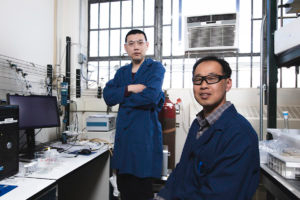Mar 10 2020
A recent innovation in splitting water into its parts can enable renewable energy to pay off, even when the sun is not shining and the wind is not blowing.
 Dongguo Li, (left) and Yu Seung Kim, Los Alamos National Lab. Image Credit: Washington State University
Dongguo Li, (left) and Yu Seung Kim, Los Alamos National Lab. Image Credit: Washington State University
Water splitting is a process that utilizes electricity to split water (H2O) into oxygen and hydrogen. Utilizing wind power and solar power when they are available for water splitting provides a method to preserve energy in the form of hydrogen fuel.
The most well-known system that is currently utilized for water electrolysis, or water splitting, depends on precious metals as catalysts. However, a collaborative research group, which included researchers from Washington State University (WSU) and Los Alamos National Laboratory, has devised a system that utilizes more abundant and less costly materials.
The researchers have explained this advancement in a study published in the Nature Energy journal on March 9th, 2020.
The current water electrolysis system uses a very expensive catalyst. In our system, we use a nickel-iron based catalyst, which is much cheaper, but the performance is comparable.
Yu Seung Kim, Study Corresponding Author and Research Scientist, Los Alamos National Laboratory
At present, the majority of water splitting is performed by utilizing a piece of equipment known as a proton exchange membrane water electrolyzer, which produces hydrogen at a high production rate.
But this equipment is costly and operates under highly acidic conditions, needing precious metal catalysts like iridium and platinum and also corrosion-resistant metal plates composed of titanium.
The researchers worked to resolve this issue by splitting water under basic, or alkaline, conditions using an anion exchange membrane electrolyzer. Such an electrolyzer does not require a catalyst based on precious metals.
Indeed, a group headed by Yuehe Lin, a professor at the School of Mechanical and Materials Engineering of WSU, developed a catalyst based on iron and nickel, elements that are more abundant and less costly in the setting.
The research group of Lin shared its development with Kim at Los Alamos National Laboratory, whose team consequently designed the electrode binder to utilize with the catalyst. This electrode binder is a hydroxide-conducting polymer material capable of binding catalysts. It offers a high pH environment for rapid electrochemical reactions.
The combination of the catalyst developed by WSU and the electrode binder developed by Los Alamos National Laboratory increased the production rate of hydrogen to almost 10 times the rate of earlier anion exchange membrane electrolyzers, thus making it similar to the more costly proton exchange membrane electrolyzer.
In the United States, around 10 million metric tons of hydrogen are presently produced every year, mainly by utilizing natural gas in a process known as natural gas reforming, as per the U.S. Department of Energy.
Hydrogen generated from a water-splitting process is energized by electricity from renewable energy. This hydrogen holds several environmental and economic benefits, stated Lin.
Water splitting is a clean technology, but you need electricity to do it. Now we have a lot of renewable energy, wind and solar power, but it is intermittent. For example, at night, we can’t use solar, but if during the day, we can use extra energy to convert it into something else, like hydrogen, that’s very promising.
Yuehe Lin, Study Corresponding Author and Professor, School of Mechanical and Materials Engineering, Washington State University
By 2023, the global hydrogen generation market is anticipated to reach $199.1 billion. Promising markets for hydrogen energy comprise everything from power grid management and mass-energy conversion to fuel cells for cars.
According to Lin, around 600 wind farms in the United States are prepared for direct connections to water electrolysis systems.
Apart from WSU and Los Alamos National Laboratory, scientists at Pajarito Powder and Sandia National Laboratories also assisted in this study. The study was funded by the HydroGen Advanced Water Splitting Materials Consortium established under the U.S. Department of Energy and Washington state’s JCDREAM program.